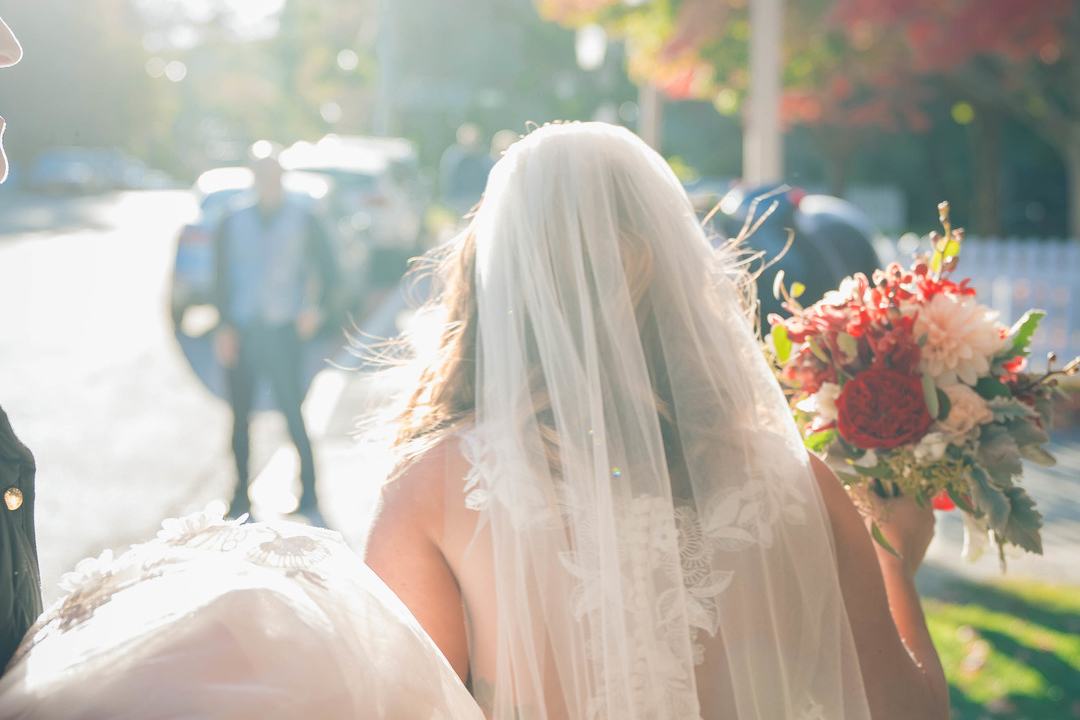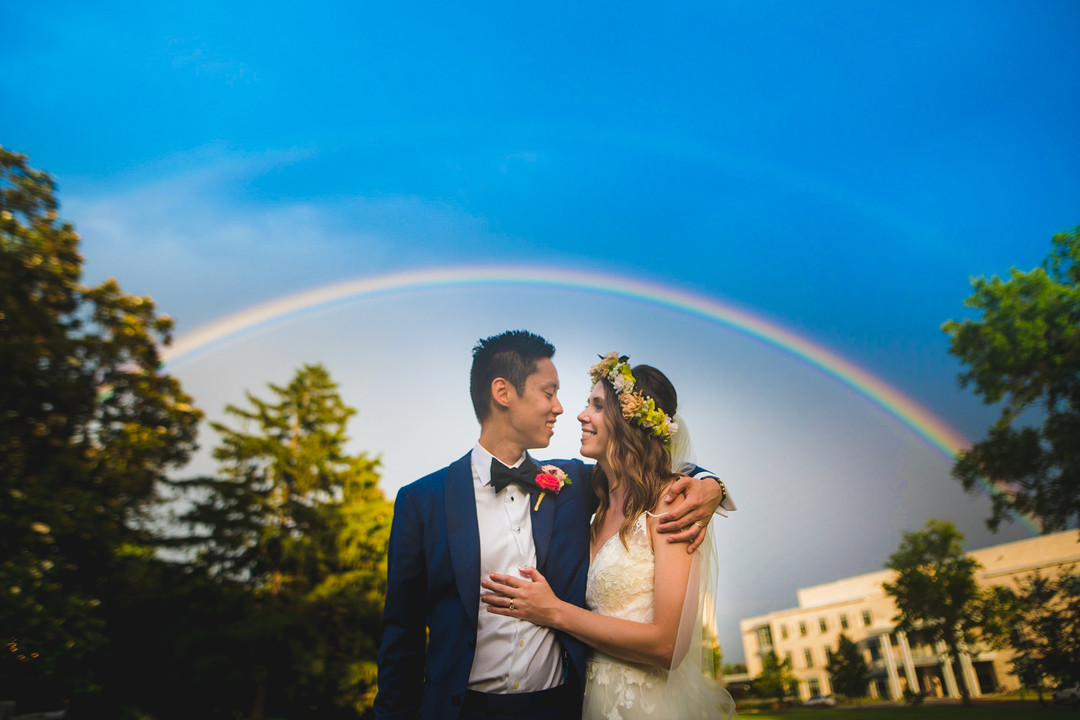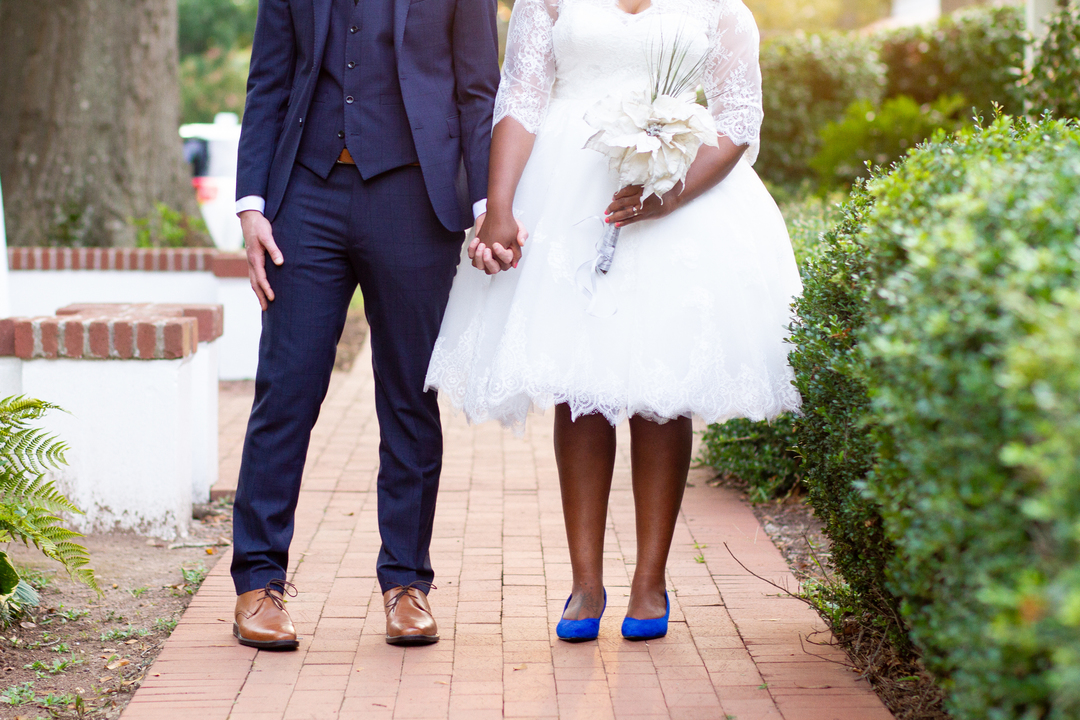- Expert advice/
- Fashion & beauty/
- Wedding dresses/
- How to Break Out of the #WeddingDiet Mentality
- Wedding dresses
How to Break Out of the #WeddingDiet Mentality
The impulse to diet or lose weight for your wedding is strong. Here's how to break the cycle and focus less on your wedding diet and more on a healthy body and stress-free wedding planning.
Last updated February 5, 2024

Whether you’re aiming for Michelle Obama arms, an exaggerated waist-to-hip ratio, or you’re trying to get back to your college weight, the concept of the wedding diet is nothing new. We’ve heard “the photos last a lifetime” more times than we can count—and we know most brides have, too.
In fact, a study from the Journal of Health Psychology revealed just how much the #weddingdiet mentality pervades the planning experience. The study found that 75% of brides polled intended to exercise more and follow a healthy eating plan prior to their wedding and 35% planned to cut out fat or carbs from their diets entirely before their wedding day.
We understand the desire to “look your best” on your wedding day. However, we like to think that your best is actually you, happy and healthy, surrounded by your loved ones and marrying your partner. Does it get any better? That said, we know breaking the wedding diet urge is easier said than done. So, we talked to dietitians and mental health experts about the underlying issues of the wedding diet culture and how to focus less on weight and more on wellness.

Don't cave to pressure.
Social media is an accessible source for inspiration and an easy way to share your wedding planning journey with a wider circle. If you’re one for regular sharing, the pressure to impress your social media circle may feel heavy. You know how many eyes see your posts after all. Plus. if you’re active in any wedding communities or follow a lot of new brides on Instagram, you already know how easy it is to fall into the comparison trap. Comparison is the thief of joy, though. The key here is to apply blinders, as necessary.
Even though we know social media isn’t always reality, it’s hard to break out of that mental state. Fortunately, there are tools you can use when you’re feeling particularly triggered or down. Mute any accounts that distract you from your planning journey, unfollow anyone who you regularly compare yourself to in a negative way, and even take a full break from social media if you need it.
A good test that it’s time for a break? If you feel like you have to post or that you have to post certain things to live up to an ideal aesthetic, it’s time to step away from the screen.
Avoid setting specific goals.
One of the main rules of goal-setting is to “make it specific.” Well, allow us to unravel that thinking and recommend avoiding specificity as you can. Common specific wedding diet goals include:
- “I want to lose 10 pounds.”
- “I want to fit into my college size X.”
- “I want to eat Y amount of calories per day.”
- “I want to work out four times per week.”
While these goals create benchmarks you can work towards or can help you track clear progress, they can be damaging—especially as you take on planning a wedding. “Wedding planning can be financially and mentally stressful enough,” says Janis Isaman, owner of Calgary’s My Body Couture. “You don’t need to add more strain to your body by bombarding it with strenuous exercises [and food restrictions] that the body isn't used to.”
Use exercise to reduce stress
Isaman recommends prioritizing exercise that makes your body feel good while also reducing stress. “Add a block of time three or so days a week to your calendar so that you can balance [wedding planning] stress with feel-good, body-and-mind restorative activities.” She suggests riding bikes with your partner, going for a walk or hiking in the woods, and yin or restorative yoga.
Nourish your mental wellbeing
One of the best ways to move away from so much focus on the body and weight is to focus on the mind. Living in a body-positive mental headspace can help alleviate feelings of inadequacy or that pull to perfect or change the healthy body you have.
Approach wedding dress fittings from a positive perspective
Wedding dress shopping can be riddled with high expectations and a lot of focus being placed on your body. Unfortunately, it’s easy to slip into the mindset of the dress making you, when it reality, it’s you that makes the dress. What’s important, here, is that leading up to your wedding gown appointments you begin to build the right mindset. The best wedding dress is the dress that makes you feel beautiful and the most like you—in the body you already have. You don’t need to achieve a certain shape, size, or number in order to look incredible right off the bat. You already do.
We know, easier said than done sometimes. Even so, it’s paramount that you keep a few tips in mind while shopping and trying on wedding gowns. First being: Buy your current size (or whichever is nearest too, if not slightly bigger than, your current measurements). It’s easier for seamstresses to take in a garment than add fabric (that said, it isn’t impossible).
Second being: Surround yourself with a supportive shopping posse. Whether you invite all of your bridesmaids or a select few friends and family members, ensure that your group is filled with people who are prepared to genuinely hype you up. Sometimes, it’s easier for others to see and appreciate your own beauty. If your body confidence isn’t at an all-time high, invite along those who will help make you feel as stunning as you are, wherever your shopping takes you.
Understand different dress silhouettes
Another key aspect of wedding dress shopping is understanding the differences in wedding dress silhouettes. Wedding dress styles vary greatly, with different shapes and structures drawing attention to different parts of your body. While you can wear any type of wedding dress you please, regardless of body type, you may be on the lookout for one that especially accentuates something about your body that you love—be it your natural curves and hourglass figure or narrow hips and small bust. Whether you’re a petite bride, athletic bride, plus-size bride, or any kind of body in-between, you can celebrate your body shape with many different silhouettes.
In your search for the perfect wedding dress, we’ve ironed out—excuse the pun—a few different kinds of dress silhouettes and what features they often compliment. That said, these are merely the details of each silhouette. Don’t take them as law and do try on a bit of everything as you shop. You never know what you might fall in love with.
Below are the eight types of wedding dresses you should know the basics of.
A-line
The a-line silhouette is fitted at the waist before flaring out into an “A” or triangle shape from the front. A-line gowns are considered to be universally flattering, with a softness in the skirt and contrasting structure in the bodice that brings attention to one’s waist. Because it doesn’t hug your hips or legs, it can even add the illusion of height. If you like the idea of showing off your shoulders and clavicle area, we highly recommend going strapless.
Ball Gown
The ball gown, while similar in shape, tends to have a lot more volume in the skirt. Often described as looking princess-like, ball gowns are a style of fit-and-flare silhouette which is fitted at the waist before flaring outward. This style tends to compliment and balance out larger chests, while its voluminous skirt highlights one's hips.
Mermaid and Trumpet
Mermaid and trumpet silhouettes are generally similar, but possess their key differences. Mermaid dresses contours to your chest, waist, hips, and knees, then flares outward from there. It’s a favorite of curvy brides, emphasizing and celebrating one’s curves.
Likewise, the trumpet silhouette draws attention to one’s curves, though the overall shape is a touch more toned down. Rather than flaring out at the knees, it does so a bit higher up, starting at the mid-thigh. It gains it’s namesake from its shape mimicking the bell of a trumpet horn.
Slip and Sheath
Both of these styles tend to be exceptionally minimalist and chic. With little to no beading or embellishments, the attention is mostly—if not entirely—on its shape.
Slip dresses are less fitted than mermaid and trumpet dresses, often made with lightweight fabrics such as silk. That said, they’re still somewhat form fitting and figure-accentuating. Due to their simplicity, they can bring attention to your height. They also often possess details that can draw attention to other parts of your body, such as a cowl neck to show off your décolletage or a low back to bring attention to your back.
Sheath dresses are similarly minimal, with a silhouette that’s fairly snug on the body. However, it doesn’t define the waist as much as a more form-fitting dress. Rather, it gives the body a soft contour and can add definition and height.
Column
Column gowns largely differ from the former two silhouettes in that they’re more structured. Created with fabrics such as brocade, taffeta, and crepe, they’re meant to give the appearance of long, straight lines. This allows them to compliment the sleek and more straight elements in one’s figure, such as more athletic or slender torsos and hips.
Empire
Flowy, boho prides have long favored the empire silhouette for its romantic and soft appearance. The empire dress is fitted at the bust, then flows the rest of the way down the body. Typically constructed in light and airy fabrics, it softens and elongates the entire body. With the absence of a defined waist, the eye is drawn to one’s décolletage and neck. This also tends to be a favorite of pregnant brides who wish to either subdue or show off their bump without going form-fitting.

How to Feel More Body Positive
Dr. Nicole Siegfried, a leading psychiatrist and Chief Clinical Officer at Alsana, lays out actionable tips to practice body positivity as you wedding plan. See them below:
Move to a place of gratitude
“Gratitude is the most powerful way to address negativity and is one of the only emotions that can be generated on command or demand,” Siegfried says. Practice latching onto gratitude in a variety of ways, especially when it comes to appreciating your body. “For instance, rather than focusing on the size of your stomach, think about why you are grateful for your stomach: [it provides] the ability to consume valuable nutrients.”
Focus on function rather than appearance
“Shift your thinking to focus on what your body can do rather than what your body looks like,” she says. For example, instead of thinking, “my legs look huge,” try thinking about all of the activities you can do with your legs: walking your dog, going for a run, standing in line at the coffee shop, etc.
Realize your body is a gift
“Our bodies are our friends that take care of us in a way we often misinterpret and don’t recognize,” she says. “When we develop an illness or injury, whether big or small, our bodies work to heal us.” Concentrate more on the marvel of your body than the mistakes.
Silence the bully in your head
“Women are conditioned to think negatively about themselves due to negative influences in society. It’s time to break that cycle and silence internal bullies by shifting that language into words of encouragement and positivity,” Siegfried says. Practice pretending you’re talking to your little sister or daughter. If the words you’re telling yourself aren’t something you would say to them, then you shouldn’t say it to yourself.
Power of self-compassion
“From gratitude comes the advanced emotion of compassion,” she says. Practice directing feelings of compassion to your relationship with your body. Apologize and begin making amends to your body for all the negative things you may have said or done to it.
Eat to feel good, not to look good
Eating in a way that makes us feel good, without focusing on the number on the scale, is bound to cause less stress before the big day. According to Registered Dietitian Diana Gariglio-Clelland, not only can eating nutritious foods better our bodies physically, but it can also lead to wedding day benefits that go beyond what we imagine. So, basically, focusing on a balanced, nutritious diet can also have some attractive (pun intended) outward side effects, too.
Nutrient-dense food can help promote a healthy digestive system. This helps to reduce bloating and other digestive discomforts, which means you’ll feel fabulous during both your wedding planning and celebration. Additionally, avoiding inflammatory foods like processed carbs or sugar can reduce painful breakouts and other skin related issues.
When it comes to changing your diet habits, don’t go too big too soon. Forget specific calorie counts. Instead, release the pressure of specific numbers and focus on more general wellness milestones. Cut back on soda, swap half of your spaghetti with zucchini noodles, and start your morning with a full glass of water. You’ll be surprised how small changes add up to make you physically feel better.
Have fun planning your wedding day
If your wedding planning process is too fixated on looking a certain way or fitting into a certain outfit or gown, you won’t enjoy it. Take this time to be present with your partner, the person who reminds you how beautiful you really are. There are one million large and small details that go into a wedding. Don’t let an intense focus on a #weddingdiet or other absurd physical pursuit distract you from the actual point of it all.
There’s no denying that wedding planning comes with its share of stress points and difficult times—worrying about your appearance shouldn’t be one of them. If it is a little, that’s OK—again, it’s normal to want to look your best. Just stay aware of how much emphasis you’re really putting on looks. Engage in healthy mind and body practices and you’ll guarantee that a wedding filled with positivity and optimism.
- Expert advice/
- Fashion & beauty/
- Wedding dresses/
- How to Break Out of the #WeddingDiet Mentality
Find even more wedding ideas, inspo, tips, and tricks
We’ve got wedding planning advice on everything from save the dates to wedding cakes.
